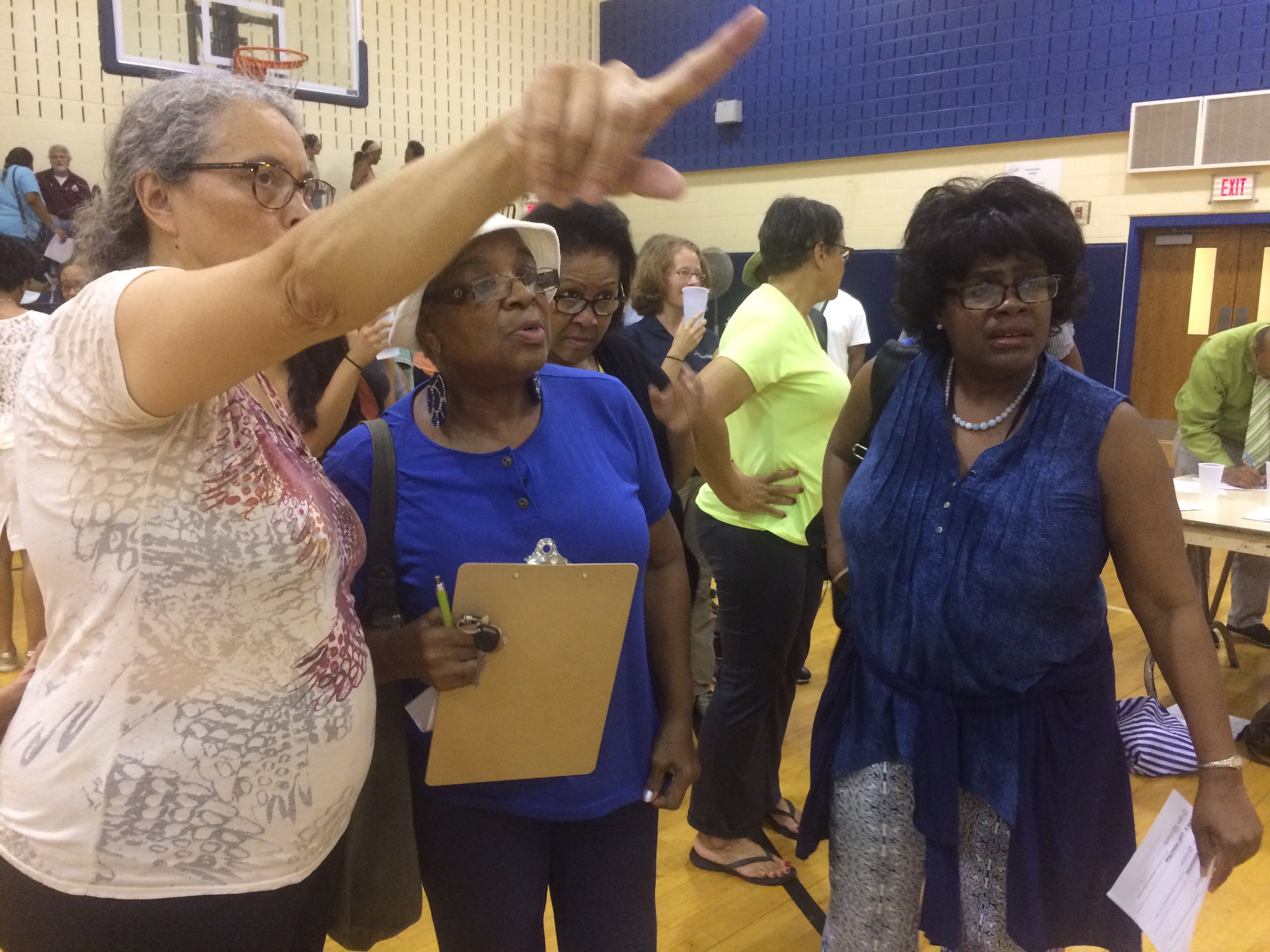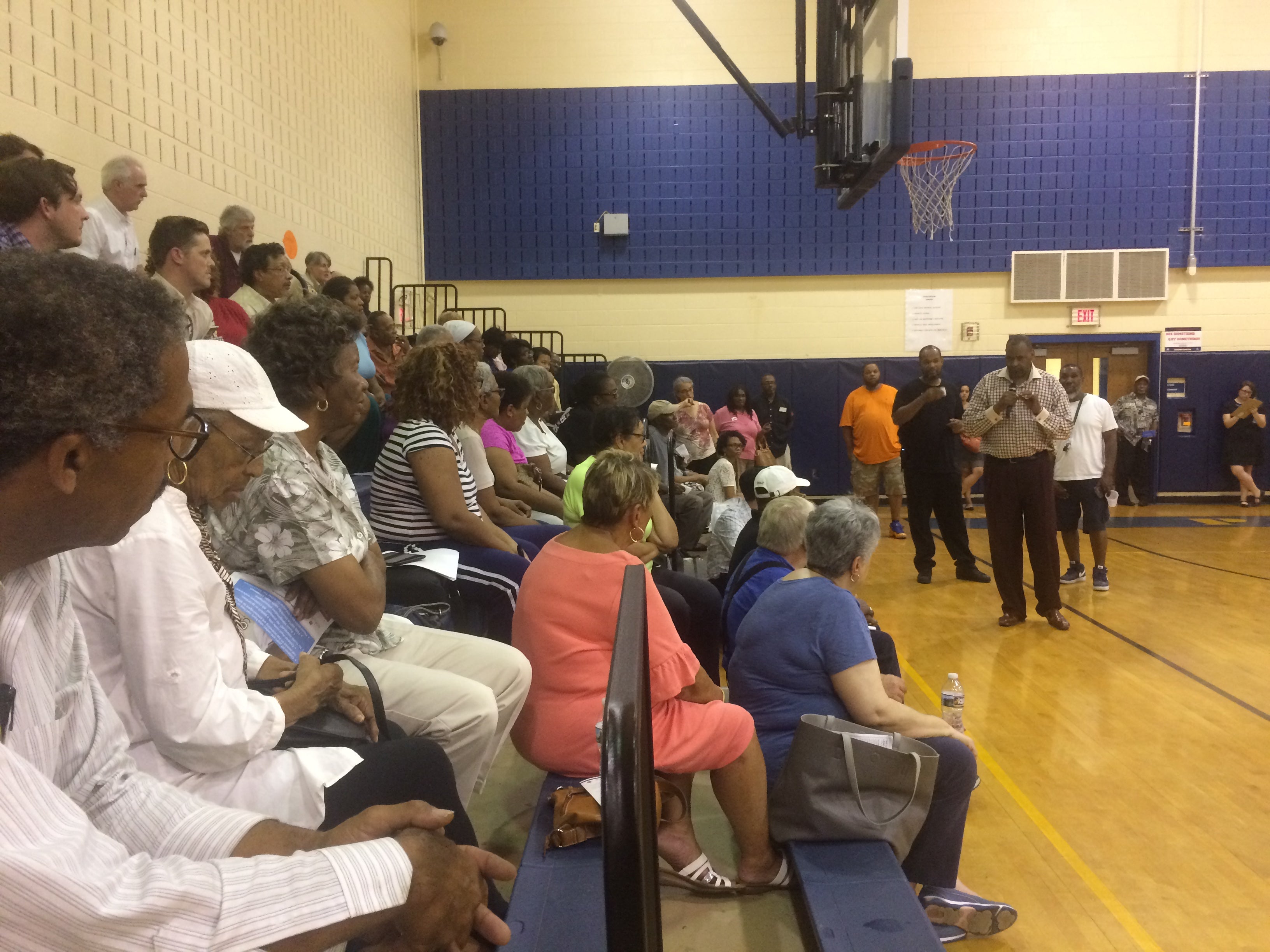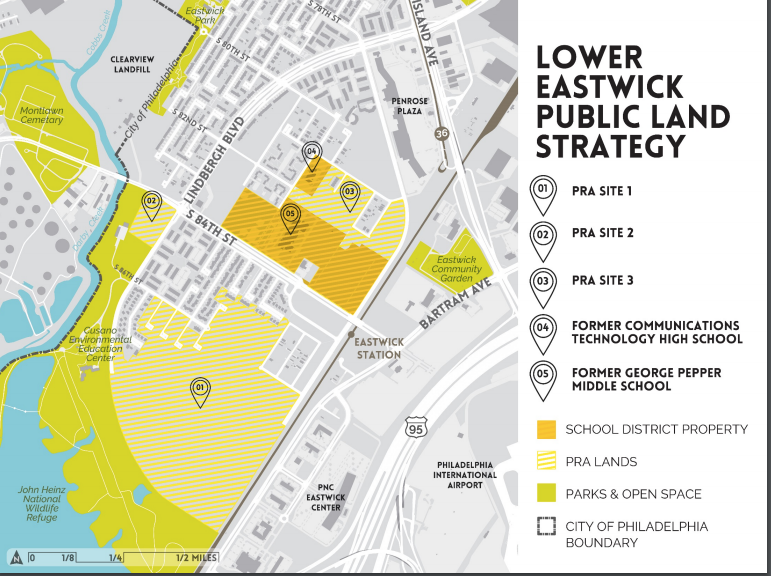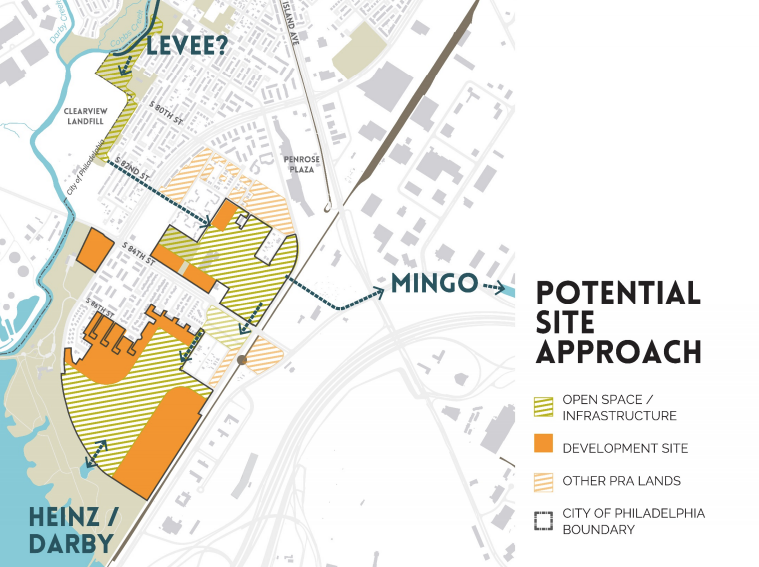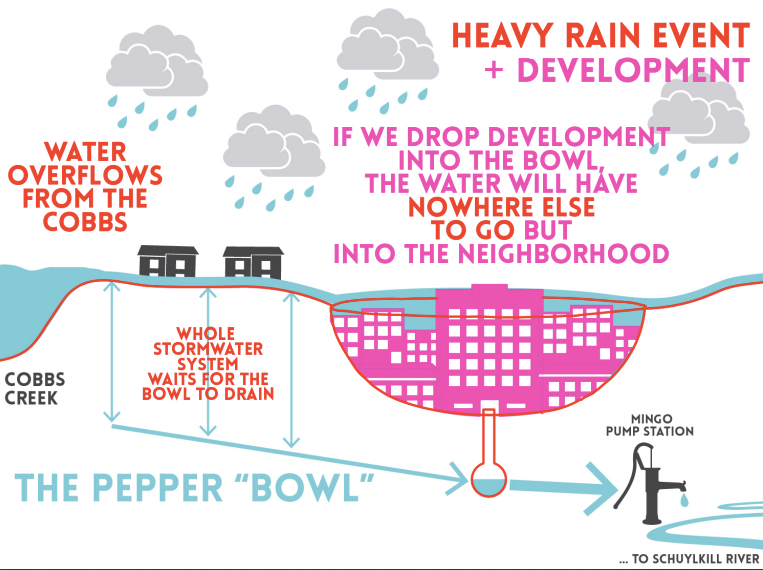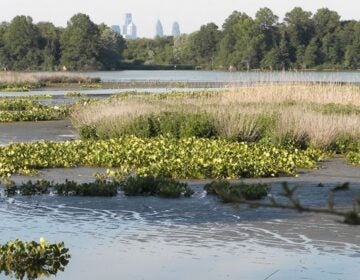Ten months into planning process, Eastwick residents remain wary and divided
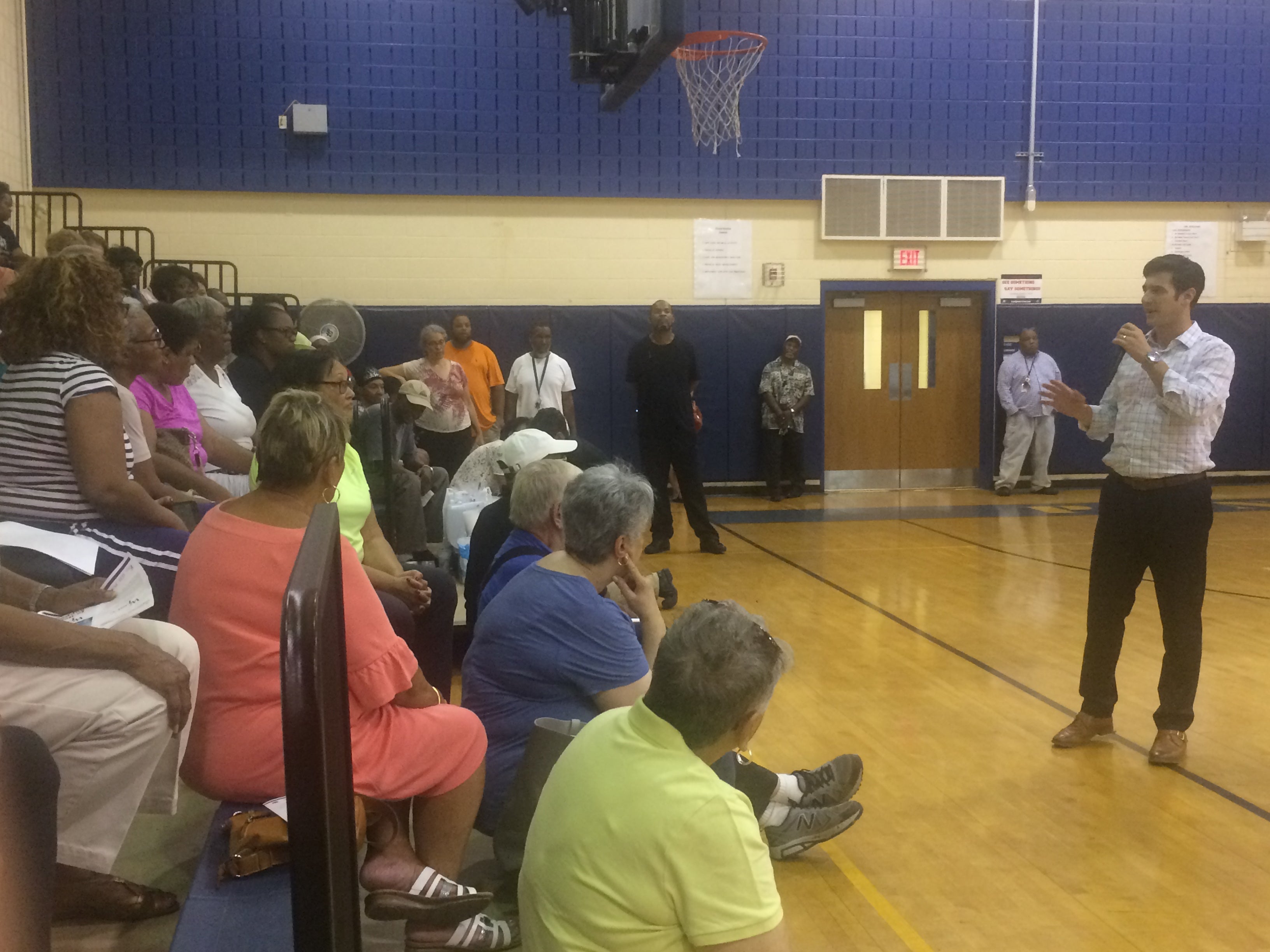
Eastwick’s Penrose Elementary School gym was packed and hot on last Wednesday night, and it wasn’t because of a game.
The school, located on 78th street, just two blocks from Cobbs Creek, was hosting the second public meeting in a 12-month planning process to decide the future of 200 acres of publicly-owned land in the neighborhood, in Southwest Philadelphia. Most of those acres — nearly 135, bounded by 84th Street, Lindbergh Boulevard and Mario Lanza Boulevard — were obtained by the City of Philadelphia through a settlement agreement with the company behind an urban renewal project in the 60s that displaced more than 6,500 residents and never fulfilled its promises. When that same developer, New Eastwick Corporation, announced its plan of building 722 extra housing units in 2012, Eastwick residents fought back, arguing that impervious surface would make the neighborhood’s historical flooding problem worse.
Five years later, and ten months into the planning and feasibility study led by Interface Studio to find out the residents’ vision for that land, what can the market support, what can be built in those acres and what is responsible to build there from an environmental standpoint, the community remains reticent and divided.
Leaders from Eastwick United, a community group, say they don’t trust the planning process because they think the city already has an agenda.
“I would like to set the record straight,” Eastwick United’s president Tyrone Beverly said. “The airport has the first right for the land. I will repeat that: The airport gets the first right to the land. Not you.”
Philadelphia International Airport is a city agency under Philadelphia’s commerce department. It is the City of Philadelphia that has the right of first refusal. Philadelphia Redevelopment Authority spokesperson Jamila Davis said that the city, were it to exercise its rights, could direct different city agencies to purchase the land. “The Airport is a City agency that has been a key partner and stakeholder in this community,” Davis said in an email to PlanPhilly. “That agency owns several parcels of land in that area, a large provider of employment, and has shown interest in being a community partner since this process began.”
Eastwick United isn’t the neighborhood’s only community group. The Eastwick Friends & Neighbors Coalition (EFNC) is less distrustful of the planning process and city government as a whole as a whole.
Earl Wilson, an EFNC leader, said many residents haven’t participated in the planning process before, so they don’t know the work that has been done to get to this point.
“A lot of manpower went into this, and it’s extremely important for those who might think that we don’t need development to begin to take a second look at this thing, cause we need development in this area,” Wilson said. “We need to make absolutely sure that whatever ideas we come up with will actually be beneficial for people in the community, without causing any problems for them.”
While most of Eastwick residents have expressed a need for development — schools, rec centers, stores, commerce — many remain fiercely opposed. At the meeting, a woman, who declined to give her name, said Eastwick needed flood prevention, not development.
“Why are we talking about developing at all? Why can we just talk about flood mitigation? No development: Fix the flooding!”
“This process can never work because the foundations ain’t right,” said Darien Thomas, a pastor and member of Eastwick United. “The airport has already been given first right of refusal for 135 acres of land. I don’t know why they would chose an organization [Interface Studio, the firm leading the study] and pay them $500,000 [it’s actually up to $254,985, split between PRA and the airport] to come to the community, when it already given the airport first right of refusal.”
Gregory Heller, head of the Philadelphia Redevelopment Authority, told the audience gathered at Penrose Elementary that the planning process would direct the land’s use..
“We’re waiting to see what comes out of this [process],” Heller said. “We’ll get this report, review it, and it will guide how we end up selling or not selling this land. Whether is the airport or anybody else, they have to go with what this study recommends.”
Interface Studio and a consultant team have been working on the planning and feasibility study since January, engaging with the community through a previous public meeting, workshops and round tables. So far, the study shows which areas are suitable for development and which should be used for green infrastructure and flood mitigation.
Doris Hutchinson, who has lived in Eastwick since 1979, said her house on Delphi Place, a few blocks from the school, is sinking. She doesn’t want development.
“Not till you fix my problem,” Hutchinson said at the meeting. “We love our houses, we love where we are, but we see so many problems — flooding, sinking — fix the problems!”
Joanne Graham, EFNC’s environmental justice chair, said she understands her neighbors’ frustrations.
“There’s a lot of environmental issues in this community, you have flooding, you have sinking homes, you have short dumping, pollution, a lot of asthma,” Graham said. “So people are concerned and are fed up. And I know that a lot of folks are angry. But this process is to help address some of this issues, not to exacerbate them. And I don’t think they’re very clear about that.”
The differences of opinion on development don’t fall neatly along the lines of the two community groups — some Eastwick United members want development, some EFNC members don’t.
“We need more development,” Pastor Thomas of Eastwick United said. “If we don’t get development, what’s going to happen is someone with big dollars — a developer — will come in, later on. All he needs is some money and get a politician to back him, and he will come here and build something big and then we will have to move out. That’s the pattern.”
EFNC’s Graham said she understood Eastwick United’s distrust.
“Some folks don’t trust the process because they feel that the city has been against the community, or working against the community, going back 50 something years when the Redevelopment Authority just came in with a blight certification, eminent domain and people were forced out,” Graham said.
Still, she’s hopeful.
“Despite the differences in opinions and attitudes, we are working together, many of us, all of the different groups,” Graham said. “We have come together because one thing we all agree on is that we want this community to be safe, protected and a beautiful place for us to continue to live and for our children and their children, if they so choose, to continue to live here. We all agree on that.”
The feasibility plan recommends against developing the former Pepper Middle School site, which they call the “Pepper bowl” because it’s the lowest elevation point of the neighborhood — reaching 2 feet under sea level — and when it rains, water naturally pools there.
“If you put something in it, you displace the water, there’s no place for the water to go,” Interface Studio principal Scott Page said. “If you put a lot of development in the bowl, the water is going to rise and it’s going to flood the surrounding houses. So we have to be very, very careful.”
But a lot of residents don’t want to lose the Pepper School.
“I want to see the school stay there,” Eastwick United’s Kenny Green said.
“It’s the only institution we have,” Pastor Thomas said.
Beverly argued that if the 135 acres south of 84th street were used for flood mitigation, then the former school site wouldn’t get flooded.
At the end of the meeting, residents gave feedback to Interface Studio on what they want to see built — or not built — in the areas where development is possible. The consultants will then refine the feedback into the draft ideas and present them to the community at the third public meeting on November 2nd. Then, at the end of the year, Interface Studio will present a final plan.
WHYY is your source for fact-based, in-depth journalism and information. As a nonprofit organization, we rely on financial support from readers like you. Please give today.



